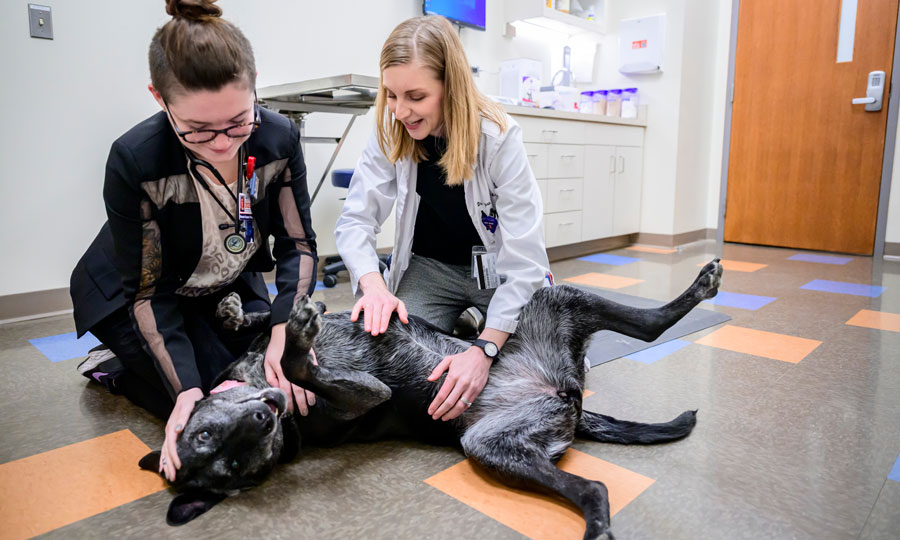The physical examination helps prevent disease
From molecular and genetic testing to advanced imaging using magnetic resonance or computed tomography, veterinarians have many tools available to diagnose their patients. Even with these technological aids, the physical examination remains the most basic yet important of diagnostic tools. Dr. Ashley Mitek, a faculty member at the University of Illinois College of Veterinary Medicine, coaches veterinary students on mastering this tool.
![[Dr. Ashley Mitek in the Illinois Clinical Skills Learning Center]](https://vetmed.illinois.edu/wp-content/uploads/2021/04/pc-mitek-cslc-214x300.jpg)
An important complement to the physical examination is the health risk assessment, during which the veterinarian asks questions about behavioral or environmental factors related to the pet’s health. Common questions include “Does the cat go outside?” or “Does the dog go to the dog park?”
Prevention Is Key
Disease prevention is the best way to keep a pet healthy.
“Preventing disease is a lot easier and less expensive than treating disease,” says Dr. Mitek. Physical examinations and wellness checkups prevent disease by keeping vaccinations up to date, educating owners on health promotion, and identifying disease before it becomes severe.
“A good physical examination will catch dental disease, osteoarthritis, cardiac disease, and dermatological disease in the early stages,” says Dr. Mitek.
She has seen many animals arrive at the Veterinary Teaching Hospital with vague or nonspecific symptoms only to be diagnosed with a serious problem that was caught early enough to cure. “One patient had a very small eye tumor that the owner could not see, but the veterinarian saw it during a routine physical examination,” Dr. Mitek says. The tumor was removed successfully, eliminating what might have developed into systemic cancer.
Frequency of Exams Depends on Age
How often pets should have wellness checkups depends on their life stage. Puppies and kittens may need monthly exams to ensure that they are growing and developing appropriately. These visits also teach pets that trips to the veterinarian are routine and fun and allow the pet and owner to develop a bond with the veterinarian.
Adult pets need a yearly wellness exam to check for health issues and to give owners an opportunity to ask questions.
“Pets age much faster than people do,” Dr. Mitek says. Geriatric pets—which could be defined as a patient that is in the last 25 percent of their lifespan—should have wellness exams more than once a year. Labeling a pet as “geriatric” is not an exact science, but typically may start around 8 years of age for cats and at 6 to 9 years of age for dogs, depending on size and breed.
Partners in Health
“Veterinarians encourage pet parents to be health advocates for their pets. There are many things pet owners can do at home as part of their pets’ healthcare team,” Dr. Mitek says. Among the most basic is providing a well-balanced diet and appropriate exercise to keep your pet at a healthy weight.
Also important, though less faithfully implemented, is home dental care. Dr. Mitek advises brushing your pet’s teeth daily. “This can be difficult to fit into your daily routine, but it is so important to the overall health of your pet,” says Dr. Mitek.
When it comes to bringing your pet in for regular physical examinations, Dr. Mitek offers these tips for making the experience more enjoyable for you, your pet, and your veterinarian:
- Make going to the veterinary clinic a positive experience. Use treats or toys to make the visit fun for the pet.
- If a pet is particularly anxious about the veterinarian clinic, consider using pheromone products, such as Feliway (for cats) or Adaptil (for dogs). These products come in wipes and spray forms and can really help to calm the animal.
- If a pet is fearful or aggressive, consider discussing an in-home sedation protocol with your veterinarian. There are several oral medications that a veterinarian can prescribe to reduce your pet’s anxiety before arriving at the clinic.
If you have questions about the physical examination or wellness checkups—or if it’s time to schedule an exam for the pet in your life—contact your local veterinarian.
By Beth Pieper

![[Illinois veterinary students practice a physical examination]](https://vetmed.illinois.edu/wp-content/uploads/2021/04/pc-mitek-phys-exam.jpg)


